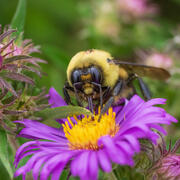USGS Native Bee Inventory and Monitoring Lab at Eastern Ecological Science Center
USGS Native Bee Inventory and Monitoring Lab at Eastern Ecological Science CenterThe USGS Native Bee Inventory and Monitoring Lab designs and develops large and small scale surveys for native bees. As part of this work we also develop identification tools and keys for native bee species. One aspect of creating those tools is creating accurate and detailed pictures of native bees and the plants and insects they interact with.















